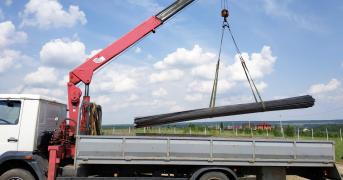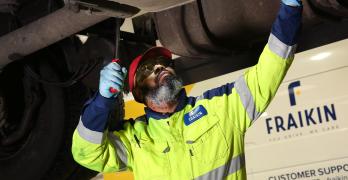Choose your loader crane carefully
- 15/06/21
- 4 min
Choosing a loader crane involves more than determining the reach and lifting capacity required for the task. It is also about guaranteeing everyone’s safety and selecting the options that will facilitate its use by an inexperienced crane operator. Still under development, connected maintenance plays a part in the availability of truck cranes.

There is a wide range of loader cranes available and there are now ranges dedicated to specific tasks. However, the construction trades represent the core of the market. Their cranes are used with hooks to load big bags, with pallet forks or even grab buckets for moving bulk materials. The assembly of frames, the handling of machines or pruning are just some of the possible uses of a crane depending on its optional equipment. Environmental trades also make use of truck cranes, specifically with the wider use of voluntary waste drop-off points where waste must be collected from the bags placed in the buried columns.
A loader crane for each trade
The main characteristic of a crane is its lifting capacity, expressed in tonnes-metres ™. The offering is extensive from a small crane at less than 1 tm for a utility vehicle to cranes at over 100 tm. Cranes between 15 and 25 tm represent the core of the French market. The latter consumed 4032 loader cranes in 2019, an exceptional year since the average for the French market is around 3000 units per year. In France, Palfinfer, Hiab and Fassi account for 9 out of 10 sales with Atlas, Cormach or PM in second place. Palfinger and Hiab dominate at European level.
Electronics assist the crane operator
Just like experienced and specialist drivers for certain modes of transport, there is a shortage of experienced crane operators. Therefore, crane manufacturers have developed systems to simplify the operation of loader cranes. However, it is common for their use to require a special qualification. As an example, in France, this is the CACES R490.
The accurate operation of a crane requires coordination of the articulations and the telescopic deployments. To simplify use, new remote controls manage this coordination. To relieve the crane operator from repetitive operations, loader cranes are now able to manage such things alone. Therefore, a bag removed from a voluntary waste drop-off point may be unloaded automatically, as illustrated in this video from the supplier Hiab.
Used in the training of crane operators providing excellent simulations, augmented reality headsets are useful in real-life operations. They provide perspectives not accessible from the ground thanks to cameras placed on the boom. For everyone’s safety, the automation of crane deployment and folding is becoming more widespread. Most incidents occur during these operations which are sometimes carried out in a rush. Another example provided by Hiab here.
Electric cranes need to be silent
The hydraulic pump that drives the loader crane is commonly driven by a power take-off on the transmission. Based on this principle, the operation of the loader crane requires that of the combustion engine. Yet urban and night-time work requires silent cranes. The electric drive provides this silence. This involves combining an electric motor with the hydraulic pump. This motor is powered either by a dedicated battery pack or by batteries mainly intended for vehicle traction in the case of a truck with an electric drive. Regardless of the principal motorisation, Hiab offers an “e-PTO” solution (electric power take-off) which combines the electric drive of the hydraulic pump and the necessary batteries. Silence comes at a price due to the cost of the batteries and their negative impact on the vehicle’s payload.
Loader cranes move to connected maintenance
In the event of unexpected downtime, a loader crane causes a significant operating loss. Therefore, its conditions for use and its technical state must be monitored. This is the role of connected maintenance. Thanks to this, overloading or the movement of a non-folded crane are indicated. To avoid a breakdown, preventive maintenance can be carried out as soon as the connected loader crane indicates pollution of its hydraulic oil or any other fault.
As the fleet manager is aware of the crane’s precise operating conditions, they can check that it is correctly sized for the tasks it performs. If this is not the case, the equipment may be used for other tasks that it can perform optimally. When the fleet is renewed, this knowledge of the use will allow accurate definition of the handling tool so that it corresponds exactly to needs. If undersized, this crane will be overstretched and will be exposed to a high risk of breakage. If oversized, it will be expensive and heavy, difficult to move and disadvantageous when it comes to the useful load of the vehicle it carries.
A loader crane is versatile and may open up new markets to its user simply by changing the accessory at the end of the boom.
Also worth reading

Labour’s Autumn Budget Uncertainty Highlights the Value of Contract Hire

Driver walkaround checks: Why they matter and how Fraikin is making them easier

